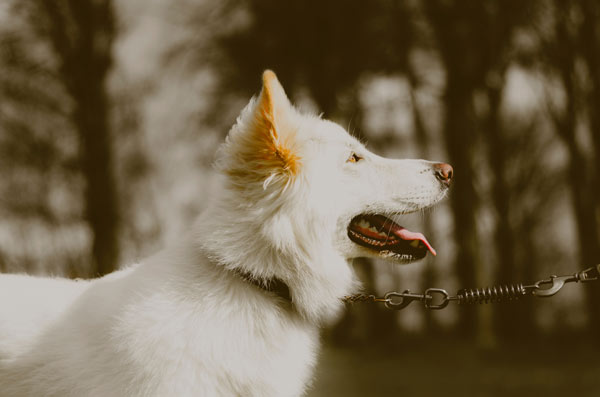Teaching the “Heel”
Take your dog on regular walks with a leash. This is important not just for training, but for his physical and mental health. Depending on what breed of dog you have, he may need a lot of exercise to keep him happy and in shape.
Pair the behavior with a verbal command. Once the dog walks consistently at your side, you can give the behavior a name, like “heel” or “let’s go.”
Teaching the “Come”
Understand the value of the command. The “come” is used whenever you want your dog to come to you. This command is potentially life-saving, as it can prevent your dog from running off if he gets loose.
Prepare your dog for “come” training. You always want to start training indoors (or in your fenced yard) with low distraction. Attach a 6-foot leash to your dog’s collar so that you have a way to keep his attention and prevent him from running away.
Attract your dog’s attention. You want to make him run toward you. You can do this with high-pitched noises associated with play, with a toy, with an excited clap, or just opening your arms. Running a short distance away from him and then stopping can also work, as dogs will naturally start to chase.
- Use praise and your “happy voice” to encourage him to move toward you.
Give immediate praise. Sound your clicker, give him praise in your “happy voice,” and give him a treat when your dog reaches your side.
Pair the behavior with the verbal command. As your dog begins to realize he’ll be rewarded for coming to you, start giving the verbal command “come.” When he responds to the command, reinforce it in praise by pairing it with “good”: “good come!”
Move the training to more public spaces. Because the “come” command could save your dog’s life, he must learn to respond to it even when he’s distracted. Move the training sessions from your home or yard to a public park. There are more sights, sounds, and smells demanding his attention there.
Increase the leash length. You began training with a 6-foot leash, but you want your dog to come longer distances than that. Try attaching two leashes together to increase the distance.
Work up to training your dog off the leash in a fenced environment. This will teach him to come over long distances.
- Ask someone to help with off-the-leash training. You can play “ping pong” and take turns calling the dog to each of you.
Give enormous rewards. Because this command is so important, the praise you give for performing it should be extravagant. Responding to the “come” command should be the best part of your dog’s day.
Do not create a negative association with this command. No matter how upset you are, never reinforce the “come” with anger. Even if you’re furious that your dog slipped the leash and ran free for five whole minutes, lavish him with praise when he finally responds to the “come.” Remember that you’re praising the last thing he did did, and the last thing he did was to come to you.
- Don’t ever correct, yell, yank or in any way make coming to you a bad thing. You can undo years of training with one bad experience.
- Never do something your dog won’t enjoy after giving a “come.” Though you may be tempted to give the command when you need to give him a bath, trim his nails, or cleans his ears, the “come” should always lead to joy.[5]
- If you have to do something your dog won’t like, just go and get the dog yourself instead of giving the command. Praise the dog along the way for being calm and accepting of the task. You can use treats, of course.
Go back to basics. If you have a scare where your dog runs loose and ignores the “come” command, go back to leash training. Continue working on the leash until he responds reliably to the “come.”
- Don’t rush the training on this command. It’s too important to do half-heartedly.
Reinforce the training throughout your dog’s life. Because this behavior is so important, it must be reinforced throughout his entire lifetime. If you take off-leash hikes with your dog, keep treats in your pocket to reinforce the command.
- You also want a command to let the dog know that it does not have to be right next to you all the time. Something like “free” is one way to phrase it, but the idea is that the dog can do what it wants and is not under command until you give it one.
Keep the fun going. You don’t want the dog to think that every time they come to you, the fun stops, someone puts on the leash, and they go back home. Otherwise, you will start to get less reliable and less happy “comes.” So, call the dog, praise them when they arrive and set them “free” to play again.
Acclimate the dog to collar grabs. This doesn’t have to be paired with any verbal commands. When the dog comes to you, grab his collar so he doesn’t grow skittish every time he feels someone touch it.
- When you lean over to reward him for the “come,” include grabbing the collar in your hand and petting around the neck as you give him his treat.[6]
- Once in a while, but not always, the leash should be attached when you grab the collar.
- Also, you can always attach a short leash and let them “free” again. Leashes should mean fun things are about to happen and we get to go places. There is no room for harsh corrections.
Sources:
- http://www.aspca.org/pet-care/virtual-pet-behaviorist/dog-behavior/training-your-dog
- http://www.caninejournal.com/jack-russell-terrier-personality/
- http://www.pawnation.com/2014/03/13/low-energy-dog-breeds/3
- http://www.aspca.org/pet-care/virtual-pet-behaviorist/dog-behavior/teaching-your-dog-not-pull-leash
- http://www.aspca.org/pet-care/virtual-pet-behaviorist/dog-behavior/teaching-your-dog-come-when-called
- http://www.successdogs.com/dog-training-lessons/collar-grab-game/
- http://www.aspca.org/pet-care/virtual-pet-behaviorist/dog-behavior/training-your-dog
- https://www.cesarsway.com/dog-behavior/food-aggressive/food-aggression-and-what-to-do-about-it
- https://www.cesarsway.com/dog-behavior/food-aggressive/food-aggression-and-what-to-do-about-it
- https://positively.com/dog-behavior/basic-cues/leave-it/
- http://www.humanesociety.org/animals/dogs/tips/how_to_stop_barking.html
- http://www.humanesociety.org/animals/dogs/tips/crate_training.html
- http://www.aspca.org/pet-care/virtual-pet-behaviorist/finding-professional-help

